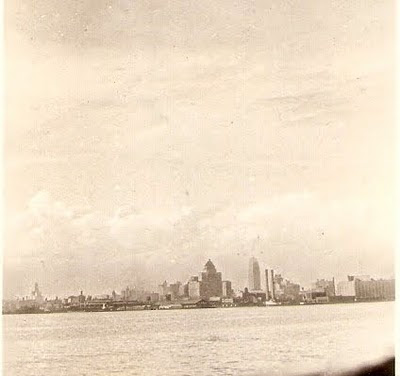
I can remember reading and hearing talk shows announcing that 'my' generation was likely to be the last who would likely expect to have one employer for life. The next generations, it was said, would be comprised of workers and professionals who would expect to have multiple employers, including being self-employed. The challenge put out to employers at the time of this theorizing then was how do you instill loyalty in employees who expect to leave you?
What of our ancestors then - if they typically had but one employer to whom they remained loyal their whole work life, how easy would it be to research their occupation and perhaps even their employment history? I'm beginning to suspect that the answer to the question is, it depends on when you asked them. Here's a case in point, my wife Ellen's maternal grandfather, Edward Arthur Latimer (pictured to the right with his youngest daughter Tess on her wedding day in 1942).
Edward was born in 1877 in the village of Seaforth, Ontario. In November of 1899, he married Harriet Sooles and listed his occupation as tinsmith. The only records earlier than this marriage record that I have found with Edward listed were the census records for 1881 and 1891 when Edward was too young to be described as having an occupation. Although he was 14 years of age in 1891, he was not even listed as a student. Tragically, in February 1901 Harriet Sooles Latimer died as a result of complications from giving birth to her and Edward's daughter (the daughter also died later in 1901). On his wife's death registration, Edward is listed as a mechanic.
By 1907, Edward had traveled to California where he met and married Mattie Diona Knox, the daughter of a former Seaforth native and then prominent Livermore, California politician Thomas E. Knox. Edward and Mattie left California immediately after their wedding and settled in Orillia, Ontario, a town about a ninety minute drive north of Toronto. There, in 1907 Mattie gave birth to their first daughter, Albertine, followed by a second daughter Hazel in 1909. Edward listed his occupation as plumber on both his daughter's birth records. In 1911, the most recent of the available census records shows Edward as recording his occupation once again, having come full circle, as tinsmith.
According to family members, Edward was in the hardware business so may he did some of everything - some plumbing (supply) work, some tinsmithing, some mechanical work - all with the intention of helping the customers of his hardware business.
My paternal grandfather, John Gaull Hadden on the other hand, married and became a father just as the world entered the Great Depression era. As a result, it seems John worked at whatever he could find to scratch out a living. Whether it was working as a day labourer and eventually settling in to a career as a milk delivery man to being an apartment building superintendent later in life, he took on work as he found it. Out of necessity, it appears he was loyal to whomever was employing him at the time.
I have essentially had one employer for my entire working career. As for my children and their children - who knows?















